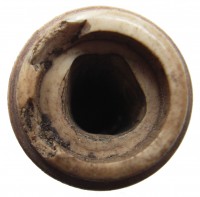 A recent study published in the Journal of Archaeology in the Low Countries reports that five small telescopes have been discovered in Amsterdam, all of them dating to the 18th century and all of them made from bovine metatarsals, the long cylindrical bones above a cow’s hoof.
A recent study published in the Journal of Archaeology in the Low Countries reports that five small telescopes have been discovered in Amsterdam, all of them dating to the 18th century and all of them made from bovine metatarsals, the long cylindrical bones above a cow’s hoof.
Although the Dutch Office for Monuments & Archaeology records over 2000 historical artifacts excavated over the past 35 years that were made out of hard animal tissue like bone, antler, ivory and tortoise shell, they’re all things like combs and buttons. Other telescopes from the 18th century have been discovered, but they’re made out of wood and metal. These five are the only bone telescopes known in Dutch archaeology.
Details of the findings hadn’t been published until now, and, in the case of two of them, were unidentified until several years ago when Rijkelijkhuizen, then a master’s degree student, started work on her thesis. She was looking at organic artifacts found in Amsterdam when she came across bone artifacts that would later turn out to be telescopes.
“At first I didn’t recognize them either,” Rijkelijkhuizen said. Her analysis of the five telescopes is now published in the most recent edition of the Journal of Archaeology in the Low Countries.
 Two of the five telescopes were discovered in cesspits, one of them dating between 1725 and 1775, the other between 1725 and 1750. We don’t have the archaeological context for the three remaining telescopes, but their style identifies them as also dating to the 18th century. Four of the five are no more than 3.5 inches long and an inch in diameter. The longest one was made in two parts that were fitted together with screw threads. The total length when both parts are attached is 5.5 inches, and the diameter at the thickest point is just a hair over an inch.
Two of the five telescopes were discovered in cesspits, one of them dating between 1725 and 1775, the other between 1725 and 1750. We don’t have the archaeological context for the three remaining telescopes, but their style identifies them as also dating to the 18th century. Four of the five are no more than 3.5 inches long and an inch in diameter. The longest one was made in two parts that were fitted together with screw threads. The total length when both parts are attached is 5.5 inches, and the diameter at the thickest point is just a hair over an inch.
 These are notably tiny dimensions for a telescope. They were bounded by the raw materials. Cow metatarsals provided an ideal round shape, thick compact bone tissue and a marrow cavity to look through, but the usable part doesn’t get much longer than 3.5 inches. The marrow cavity gets oval in shape towards the ends of the bone, so those parts had to be removed. Once they had a round bone with its round cavity lathed into shape, the craftsmen carved out a platform on each end for lenses to rest on. They then made screw threads on the outside of the ends so that lens caps could be fitted over them with metal rings.
These are notably tiny dimensions for a telescope. They were bounded by the raw materials. Cow metatarsals provided an ideal round shape, thick compact bone tissue and a marrow cavity to look through, but the usable part doesn’t get much longer than 3.5 inches. The marrow cavity gets oval in shape towards the ends of the bone, so those parts had to be removed. Once they had a round bone with its round cavity lathed into shape, the craftsmen carved out a platform on each end for lenses to rest on. They then made screw threads on the outside of the ends so that lens caps could be fitted over them with metal rings.
Both lenses are extant from the two-piece telescope and one of the lenses from the smaller telescopes also survived. We know therefore that these were refracting telescopes which would have had a very low magnification rate of about three. The craftsmanship required to make them — both the bone carving and the lens grinding — suggests that these were luxury items. They wouldn’t have been strong enough to be turned towards the heavens, so probably the telescopes were used as opera glasses or to watch the seas during a ship voyage.